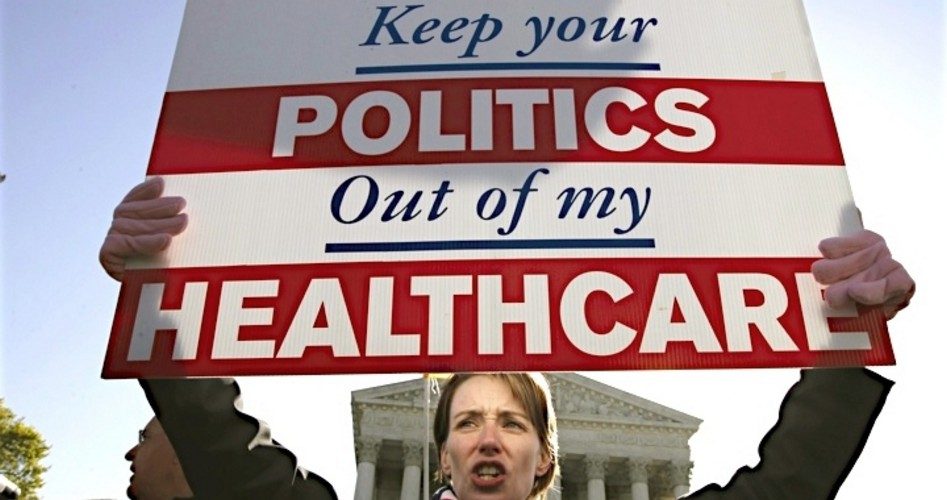
“Is ObamaCare a government takeover of medicine?” That’s the question Forbes contributor Carolyn McClanahan posed in a recent blog post, as she attempted to quell “misconceptions” about the President’s Affordable Care Act, while promoting key aspects of the law. McClanahan concedes the law is far from perfect, but that it is “the most significant attempt our country has ever made at reforming our costly and inefficient health care system.”
McClanahan goes on to dispute the common assertion that ObamaCare is a “government takeover” of medicine. Outlining how what she translates as a “government takeover,” the Forbes contributor cites the following variations:
Medicine will be a government-run entity — doctors will be employed by the government and care will be paid for by the government.
All the doctors will be employed by the government, but insurance companies will still exist.
The government will dictate what doctors can and cannot do.
The government will make it so onerous to practice medicine that everyone will quit.
McClanahan first addresses spending, citing that, in some capacity the government pays 43 to 36 percent of all healthcare costs, primarily through Medicaid, Medicare, and the military. After ObamaCare reaches full implementation, that amount will spike to more than 49 percent. “It is a clear increase, but nowhere near a 100% government-paid program,” Ms. McClanahan posits. “The private sector will still be responsible for over half of healthcare spending.”
In addition to three other U.S. healthcare systems — private insurance, Medicare and Medicaid, and coverage for the armed forces — there is something called the “self-insured system,” McClanahan explains:
[T]hese are the roughly 40 million or so people who either cannot afford coverage, choose to go without coverage, or have pre-existing conditions which make it impossible to get coverage. The uninsured are at the mercy of a patchwork volunteer system that is inefficient and expensive to run. Some of the current programs to cover the uninsured are funded by the government (taxpayers) and some through charity (benevolent taxpayers), but the majority of the uninsured are left to fend for themselves. Requiring that people obtain coverage and assisting the low income uninsured in paying for that coverage is part of the Affordable Care Act. This is greater government involvement — making people take responsibility, and assisting individuals in fulfilling that responsibility.
While it may be that ObamaCare does not represent a complete government takeover of healthcare (i.e. a single-payer system), it captures numerous components of the system, as well as partially confiscating other more obscure elements. While doctors may not be explicitly employed by federal officials, intrusive regulations have forced them to answer to the government, or their “boss,” if you will.
Government officials have called for higher quality of care, and ObamaCare grants them the authority to impose numerous quality-control standards, much like a CEO or manager would require them to do. The New American reported in May on another scheme the federal government has pursued to take over key aspects of the U.S. healthcare system:
Another regulatory burden ObamaCare imposes on insurance companies is a “rebate program” that requires providers to spend 80 percent of their collected premiums (85 percent for larger employers) on medical care or reimburse the difference to individuals and businesses. The HHS has been touting the purported “rebate program” as an indication that ObamaCare is giving back to Americans.
Highlighting the physician aspect of the debate, McClanahan exploits the claim that ObamaCare will force every physician or individual who practices medicine to leave the profession. While, of course, every doctor won’t transition to a new career, studies show that physician shortages have already become a serious problem, likely due to current and prospective components of the law’s implementation.
Furthermore, the government’s extension of coverage to millions of new Americans has already prompted doctor shortages. The New York Times reported in July that an economically-depressed region in Southern California, the Inland Empire, is expecting widespread physician shortages, as the healthcare law — and, in turn, the government — will be extending coverage in the area to more than 300,000 by 2014:
Other places around the country, including the Mississippi Delta, Detroit and suburban Phoenix, face similar problems. The Association of American Medical Colleges estimates that in 2015 the country will have 62,900 fewer doctors than needed. And that number will more than double by 2025, as the expansion of insurance coverage and the aging of baby boomers drive up demand for care. Even without the health care law, the shortfall of doctors in 2025 would still exceed 100,000.
Further revealing the government’s unrelenting expansion in the U.S. healthcare system, the Congressional Budget Office found that ObamaCare will inflate the national debt $1.36 trillion in seven years after just two crucial mandates reach full implementation. Moreover, the law adds 150 new federal healthcare missions and boards, which will further restrict the consumer’s choice in fulfilling his or her own health needs.
McClanahan attempts to belittle those ObamaCare opponents who allege, “If the government has one iota of involvement in any form, it is a government takeover.” But while President Obama’s landmark healthcare overhaul may not establish a single-payer healthcare system, it has authorized the government to take over crucial aspects of the system, so analysts can arguably conclude that the law has ignited a “government takeover.”
Photo: A demonstrator holds up a sign objecting to the Obama healthcare plan before the Supreme Court in Washington: AP Images



